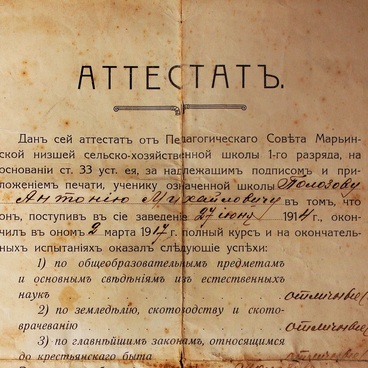The first paper money appeared in Russia in the 18th century during the reign of Catherine II. Over time, the portrait of the empress appeared on the banknotes — like the 100 rubles state credit slip issued in 1910 and housed in the Shebekino History and Art Museum. This amount of money was enough to buy a horse or a ceremonial officer’s uniform with boots and a cap, and two credit slips were enough to pay for — a grand piano of a famous brand.
The Empress was the only woman — a real historical figure — portrayed on the Russian banknotes. Until 1910, the credit slip depicted a ceremonial “Portrait of Empress Catherine II with allegorical figures of Fortress and Truth”, which was painted by the Austrian master Johann Baptist von Lampi the Elder in 1794. After the next modification of the Russian banknotes, the image was changed: a new black-and-white engraving pattern was moved to the center and placed against a light brown background.
Next to the empress there appeared an additional allegorical figure of a man wearing a chiton, a cotton ancient Greek garment. In his hands he held a sword and a laurel bouquet. If one held the banknote against the light, another portrait of Catherine II was to be seen.
Since the face value of the banknote was high, they were seldom used — mostly to pay for expensive purchases at fairs. The largest and most popular fairs in Shebekinsky volost were held in the villages of Zimovenka, Starikovo, Ustinka. Merchants and landlords from Kursk, Belgorod, Volchansk, and Kharkov came to these fairs. State and landowner peasants brought cattle and various handicraft items for sale.
Often fairs were timed to coincide with church holidays, and one-day auctions were held every week in towns and large villages. For example, a fair in the village of Zimovenka was held on St. George’s day on May 6 (April 23, Old Style). It was open for two days and in 1851 its turnover amounted to 2.5 thousand rubles.
Immediately after the issue of the 100-ruble banknote in 1910 pattern, it could be exchanged for ten gold coins with the profile of Nicholas II. Despite the revolution and the abandonment of the imperial heritage, the banknotes with the portrait of Catherine II remained in use until 1922, and then they were replaced by the Soviet Russia money.
The Empress was the only woman — a real historical figure — portrayed on the Russian banknotes. Until 1910, the credit slip depicted a ceremonial “Portrait of Empress Catherine II with allegorical figures of Fortress and Truth”, which was painted by the Austrian master Johann Baptist von Lampi the Elder in 1794. After the next modification of the Russian banknotes, the image was changed: a new black-and-white engraving pattern was moved to the center and placed against a light brown background.
Next to the empress there appeared an additional allegorical figure of a man wearing a chiton, a cotton ancient Greek garment. In his hands he held a sword and a laurel bouquet. If one held the banknote against the light, another portrait of Catherine II was to be seen.
Since the face value of the banknote was high, they were seldom used — mostly to pay for expensive purchases at fairs. The largest and most popular fairs in Shebekinsky volost were held in the villages of Zimovenka, Starikovo, Ustinka. Merchants and landlords from Kursk, Belgorod, Volchansk, and Kharkov came to these fairs. State and landowner peasants brought cattle and various handicraft items for sale.
Often fairs were timed to coincide with church holidays, and one-day auctions were held every week in towns and large villages. For example, a fair in the village of Zimovenka was held on St. George’s day on May 6 (April 23, Old Style). It was open for two days and in 1851 its turnover amounted to 2.5 thousand rubles.
Immediately after the issue of the 100-ruble banknote in 1910 pattern, it could be exchanged for ten gold coins with the profile of Nicholas II. Despite the revolution and the abandonment of the imperial heritage, the banknotes with the portrait of Catherine II remained in use until 1922, and then they were replaced by the Soviet Russia money.



